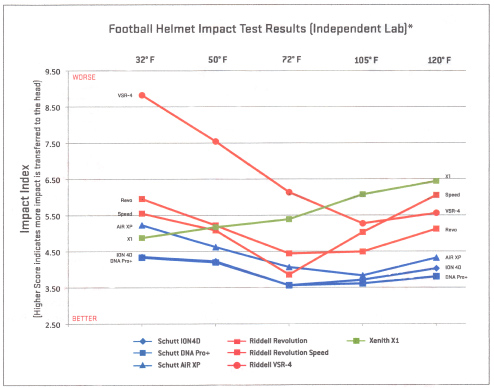Over the years, laboratories, organizations, and companies in the industry have conducted countless tests and studies to determine the safety level of football helmets.
Unfortunately, it has been observed that no person or football helmet study, up to this point, has truly rated a helmet?s ability to prevent concussions. The most advanced scientific research and medical knowledge currently available has yet to reach a point where on-field injuries can be tested in a lab and point to accurate correlations. The only organization to come close is the NOCSAE, the governing body by which all athletic equipment is deemed safe.
Recently, a study conducted by Virginia Tech has gained a large amount of industry publicity. The study tested 10 popular adult football helmet models using a Summation of Tests for the Analysis of Risk (STAR) evaluation system, giving each helmet a star rating from 5 to 1.
This study provides good data,
but has been criticized for its lack of comprehension. In fact, the NOCSAE
themselves released a
statement  ,
explaining their issues with the study:
,
explaining their issues with the study:
- Studies have long shown that most concussions are caused by helmet-to-helmet impacts, where as the STAR system tests only simulated helmet-to-ground impacts.
- Rotational forces and time duration of impact, both known factors in causing concussions, were COMPLETELY IGNORED by the study.
In 2010, the NFL conducted its own football helmet tests and their study, which included rotational forces and time duration data, found that the Schutt DNA Pro + was the best performing helmet. This study dramatically disagrees with the Virginia Tech study, yet the NFL continues to use Riddell football helmets as their official supplier.
According to NFL teams, in 2009 and 2010:
- 297 players wore the Riddell Speed Helmet (5-Star rating in VT study) and reported 30 concussions
- 303 players wore the Schutt AiR XP Helmet (3-Star rating in VT study) and reported 27 concussions
- 489 players wore the Schutt AiR Advantage Helmet (2-star rating in VT study) and reported 31 concussions
So the question must be asked; how can 3- and 2-star helmets have just as good, if not better on-field records than 5-star rated helmets, if the STAR system is said to be a true predictor of concussion prevention?
Before we answer that question, let?s look at another test conducted by ICS Laboratories in Brunswick, Ohio, which took into account temperature as well.
The following is a graph as published by ICS:

As you can see, this test's results differ from both the VT and NFL studies.
With this in mind, the answers become clearer:
- NO modern helmet is completely concussion proof!
- Each study is most likely in some way incomplete or inaccurate.
As stated by the NOCSAE, it is important to understand these studies, and use them as guides. But no study is capable of definitively determining one helmet?s complete superiority over another?s. There are countless factors that come into play when a concussion occurs, and no study can account for all of them. When it comes to your child?s or your own safety on the field, it?s important to know all you can, from as many sources as possible, to have a well-rounded opinion of each helmet, before making your decision.
